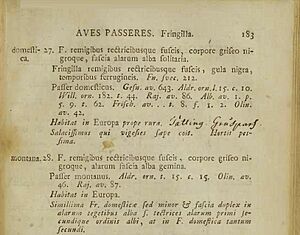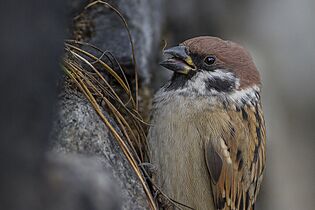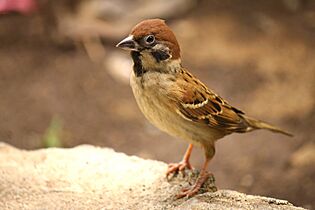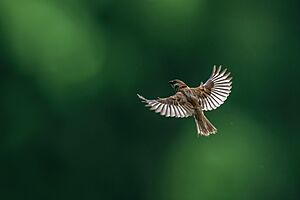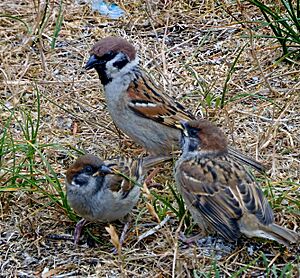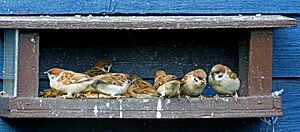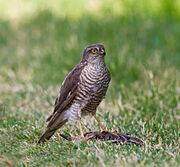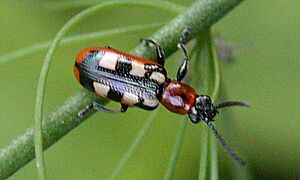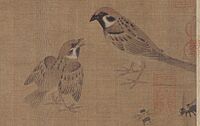Eurasian tree sparrow facts for kids
Quick facts for kids Eurasian tree sparrow |
|
|---|---|
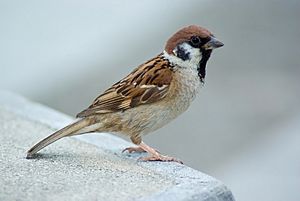 |
|
| An adult Eurasian tree sparrow in Japan | |
| Conservation status | |
| Scientific classification | |
 |
|
| Where the Eurasian tree sparrow lives
Breeding summer visitor |
|
| Synonyms | |
|
The Eurasian tree sparrow (Passer montanus) is a small bird from the sparrow family. It has a reddish-brown cap on its head and a black spot on each white cheek. Both male and female birds look very similar. Young birds are just a bit duller in color.
This sparrow lives across most of Europe and Asia. It is also found in Southeast Asia. It has been brought to other places, like the United States. There, it is called the Eurasian tree sparrow or "German sparrow." This helps people tell it apart from the native American tree sparrow, which is not related. Even though there are different types (subspecies), they all look quite similar.
Eurasian tree sparrows build messy nests. They often choose holes in trees or buildings. Sometimes, they use old nests of other birds like the European magpie. A female usually lays five or six eggs. These eggs hatch in less than two weeks. These sparrows mostly eat seeds. But they also eat insects, especially when they are raising their young. Like other small birds, they face dangers from diseases and birds of prey. They usually live for about two years.
In eastern Asia, the Eurasian tree sparrow is common in towns and cities. But in Europe, it prefers open countryside with some trees. The house sparrow usually lives in European cities instead. The Eurasian tree sparrow is not globally endangered. This is because it lives in many places and has a large population. However, its numbers have dropped a lot in western Europe. This is partly due to changes in farming. Farmers now use more herbicides and leave fewer fields with leftover crops in winter. In eastern Asia and western Australia, some people see this bird as a pest. But it is also often shown in Asian art.
Contents
What Does the Eurasian Tree Sparrow Look Like?
The Eurasian tree sparrow is about 12.5–14 cm (5–5+1⁄2 in) long. Its wingspan is about 21 cm (8.3 in). It weighs around 24 g (0.85 oz). This makes it about 10% smaller than the house sparrow.
Adult birds have a rich reddish-brown cap on their head. They have a black patch shaped like a kidney on each pure white cheek. Their chin and throat are black. Their upper body is light brown with black streaks. Their brown wings have two clear, narrow white stripes. Their legs are pale brown. The beak is blue-grey in summer and almost black in winter.
This sparrow is special because males and females look the same. Young birds also look like adults, but their colors are a bit duller. The clear pattern on its face makes it easy to spot. It is also smaller than the male house sparrow and has a brown cap, not grey. Adult and young sparrows slowly replace all their feathers in autumn. During this time, they gain body weight, even though they have less fat. This weight gain helps them grow new feathers.
The Eurasian tree sparrow does not have a true song. But it makes excited "tschip" calls. Unpaired or courting males often make these calls. Other short chirps are used when birds interact. Its flight call is a harsh "teck."
Eurasian Tree Sparrow Family Tree
The Passer genus is a group of small passerine birds. Scientists think they first came from Africa. There are 15 to 25 species in this group. These birds usually live in open areas with some trees. But some, like the house sparrow, have learned to live near people.
Most birds in this group are 10–20 cm (3.9–7.9 in) long. They are mostly brown or grey. They have short, square tails and thick, cone-shaped beaks. They mainly eat seeds from the ground. But they also eat insects, especially when they are breeding. The Eurasian tree sparrow is not closely related to the American tree sparrow. The American tree sparrow belongs to a different bird family.
The scientific name for the Eurasian tree sparrow is Passer montanus. Passer means "sparrow" in Latin. Montanus means "of the mountains." The Eurasian tree sparrow was first described by Carl Linnaeus in 1758. He called it Fringilla montana. But it was soon moved to the new Passer group. This group was created by a French zoologist in 1760.
The common name "tree sparrow" comes from its habit of nesting in tree holes. But the name "montanus" (of the mountains) does not really fit where it lives. In German and Hungarian, its name means "field sparrow." This name describes its habitat better.
Different Kinds of Eurasian Tree Sparrows
This bird looks very similar across its huge range. The differences between the seven types (subspecies) are very small. Many other types have been suggested. But they are usually seen as mixes of the main subspecies.
- The European tree sparrow (P. m. montanus) lives across Europe and parts of Asia.
- The Caucasian tree sparrow (P. m. transcaucasicus) lives from the Caucasus to northern Iran. It is duller and greyer than the European type.
- The Afghan tree sparrow (P. m. dilutus) lives in northeastern Iran, northern Pakistan, and northwestern India. It is paler with sandy-brown upperparts.
- The Tibetan tree sparrow (P. m. tibetanus) is the largest type. It lives in the northern Himalayas, from Nepal to northwestern China. It is darker than the Afghan type.
- P. m. saturatus lives in Sakhalin, Japan, Taiwan, and South Korea. It is a deeper brown and has a larger beak.
- P. m. malaccensis lives from the southern Himalayas to Indonesia. It is dark, like P. m. saturatus, but smaller.
- P. m. hepaticus lives from northeastern Assam to northwestern Burma. It looks like P. m. saturatus but is redder on its head.
Where Eurasian Tree Sparrows Live
The Eurasian tree sparrow naturally breeds across most of temperate Europe and Asia. It lives south of about latitude 68°N. North of this, summers are too cold. It also lives through Southeast Asia to Java and Bali. It used to breed in the Faroes and Malta. In South Asia, it is mostly found in temperate areas.
Most of these sparrows stay in the same place all year. But populations in the far north fly south for winter. Some also leave southern Europe for North Africa and the Middle East.
The Eurasian tree sparrow has been brought to new places. But it does not always settle well. This might be because of competition with the house sparrow. It has successfully settled in Sardinia, eastern Indonesia, the Philippines, and Micronesia. But attempts to introduce it to New Zealand and Bermuda failed. Birds carried on ships settled in Borneo.
In North America, about 15,000 birds live around St. Louis. They also live in nearby parts of Illinois and Iowa. These birds came from 12 sparrows brought from Germany in 1870. This was part of a plan to add more birds to North America. In this small US area, the Eurasian tree sparrow competes with the house sparrow in cities. So, it mainly lives in parks, farms, and rural woods. The American population is sometimes called the "German sparrow."
In Australia, the Eurasian tree sparrow lives in Melbourne. It is also found in towns in central and northern Victoria. It is not allowed in Western Australia. It often arrives there on ships from Southeast Asia.
Despite its scientific name, Passer montanus (mountain sparrow), it is not usually a mountain bird. In Switzerland, it only goes up to 700 m (2,300 ft). But it has bred as high as 4,270 m (14,010 ft) in Nepal. In Europe, it is often found on coasts with cliffs. It also lives in empty buildings or open countryside with small patches of woods. It really likes to nest near wetlands. It avoids breeding on farms that are heavily managed.
When Eurasian tree sparrows and house sparrows live in the same area, house sparrows usually live in cities. The smaller Eurasian tree sparrows nest in the countryside. In eastern Asia, the Eurasian tree sparrow is an urban bird. In southern and central Asia, both sparrow types can be found near towns. In Australia, the Eurasian tree sparrow is mostly a city bird. The house sparrow uses more natural habitats there.
Eurasian Tree Sparrow Life and Habits
Reproduction and Nesting
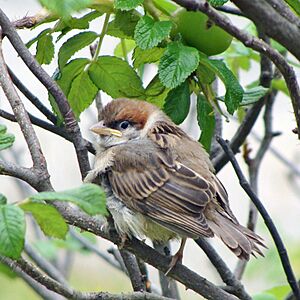
Eurasian tree sparrows can start breeding when they are one year old. They usually build their nests in holes in old trees or rocks. Some nests are built among the roots of bushes. They might also use holes in house roofs. In warm places, they can nest in palm tree tops. This bird will also use old nests of European magpies. They might even use active or empty nests of large birds like the white stork. Sometimes, they try to take over nests of other birds that nest in holes. These include barn swallows or European bee-eaters.
Pairs can breed alone or in small groups. They will also use nest boxes. One study in Spain showed that boxes made of wood and concrete were used much more often than wooden boxes. Birds in these stronger boxes laid eggs earlier. They also had more breeding attempts each season.
In spring, the male bird calls from near the nest site. This is to show it is his territory and to attract a mate. He might also carry nesting material into the hole. This showing off and nest building happens again in autumn. They prefer old Eurasian tree sparrow nests for this autumn display.
The nest is messy. It is made of hay, grass, wool, or other materials. It is lined with feathers to keep it warm. A full nest has three layers: a base, a lining, and a dome. The female usually lays five or six eggs. The eggs are white to pale grey. They have many spots or speckles. They are about 20 mm × 14 mm (0.79 in × 0.55 in) in size. Each egg weighs about 2.1 g (0.074 oz).
Both parents sit on the eggs for 12–13 days until they hatch. The chicks are born naked and helpless. They stay in the nest for another 15–18 days before they can fly. These sparrows can raise two or three groups of young each year.
Sometimes, Eurasian tree sparrows breed with house sparrows. This has been seen in many parts of the world. The male mixed birds often look like Eurasian tree sparrows. The female mixed birds look more like house sparrows.
What Eurasian Tree Sparrows Eat
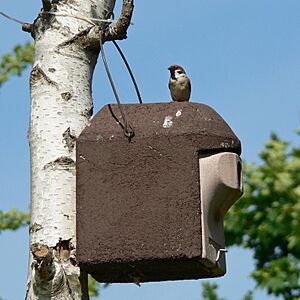
The Eurasian tree sparrow mainly eats seeds and grains. It feeds on the ground in groups. Often, it feeds with house sparrows or other small birds. It eats weed seeds and spilled grain. It might also visit bird feeders, especially for peanuts.
It also eats invertebrates (animals without backbones). This is especially true during breeding season. Young birds are mostly fed animal food. They eat insects, woodlice, millipedes, centipedes, and spiders.
Adult sparrows look for insects in wetlands to feed their young. These wet areas are important for providing enough different insects. This helps them raise chicks throughout their long breeding season. Many old farmlands no longer have these insects. This is because of intensive farming.
In winter, seeds are the most important food. At this time, birds in a group form a pecking order. But the size of their black throat patch does not strongly show their place in this order. This is different from the house sparrow. For house sparrows, the throat patch size shows how strong they are.
The danger of being eaten affects how they find food. A study showed that if food was far from a safe place, birds visited the feeder in smaller groups. They spent less time there and were more watchful. Sparrows can either look for food themselves ("producers") or join others who have found food ("scroungers"). Scrounging was more common in open, risky places.
Who Eats the Eurasian Tree Sparrow?
Many birds of prey eat Eurasian tree sparrows. These include Eurasian sparrowhawks, common kestrels, and little owls. Sometimes, long-eared owls and white storks also eat them. Their nests can be raided by European magpies, jays, least weasels, rats, cats, and snakes.
Many types of bird lice live on these birds and in their nests. Mites can also infect them, causing sores on their legs. Fly larvae can also cause many young birds to die in the nest.
Eurasian tree sparrows can also get sick from bacteria and viruses. Bacteria can stop eggs from hatching. They can also cause young birds to die. Mass deaths from Salmonella have happened in Japan. Bird malaria has been found in their blood. Birds in China were found to carry a type of bird flu that was very harmful to chickens.
The Eurasian tree sparrow's immune system is not as strong as the house sparrow's. This might be why house sparrows spread more easily. Eurasian tree sparrows are often hit by cars on roads in Europe. The oldest recorded Eurasian tree sparrow lived for 13.1 years. But they usually live for about three years.
How They Handle Temperature Changes
Eurasian tree sparrows change their bodies to deal with different temperatures. In winter, when days are shorter and it's colder, they gain weight. Their bodies also use more energy to stay warm. This is called a higher basal metabolic rate. Their bodies also produce more thyroid hormones. These hormones help control how the body uses energy. Gaining weight helps them store more energy. Using more energy helps them keep their body temperature up in the cold.
Is the Eurasian Tree Sparrow Endangered?
The Eurasian tree sparrow lives in a huge area. This area is about 98.3 million square kilometres (38.0 million sq mi). There are between 190 and 310 million of these birds. Even though their numbers are going down, they are not considered endangered. Their population is not dropping fast enough to be a concern. So, their conservation status is listed as "Least Concern".
The Eurasian tree sparrow has been spreading in northern Europe and eastern Europe. But its numbers have been falling in much of western Europe. This is a trend seen in other farmland birds too. From 1980 to 2003, the number of common farmland birds dropped by 28%. The drop has been very big in Great Britain. There was a 95% decline between 1970 and 1998.
The big drop in Eurasian tree sparrow numbers is likely due to modern farming. Farmers use more herbicides. They also plant crops in autumn instead of spring. Spring-planted crops leave stubble fields in winter, which provide food. Modern farming also uses more insecticides. This means less insect food for young birds.
Eurasian Tree Sparrows and People
In some places, the Eurasian tree sparrow is seen as a pest. In Australia, it damages grain and fruit crops. It also spoils stored grain with its droppings. Rules there stop this bird from being brought into Western Australia.
In the 19th century, many campaigns tried to catch and kill sparrows in Europe.
In 1958, the leader of China, Mao Zedong, tried to reduce crop damage. He said Eurasian tree sparrows ate about 4.5 kg (9.9 lb) of grain per bird each year. Millions of people were asked to scare the birds until they died from exhaustion. This "Four Pests campaign" did reduce the sparrow population. But it did not consider that sparrows also ate many locusts and other harmful insects. Without the sparrows, insect pests increased. Crop yields then dropped a lot. This made a famine worse, which led to many deaths between 1959 and 1961.
Because Eurasian tree sparrows eat insects, they are sometimes used in farming. They help control pests on fruit trees. They also eat the common asparagus beetle.
The Eurasian tree sparrow has been shown in Chinese and Japanese art for a long time. It is often seen on plants or flying in groups. Pictures by artists like Hiroshige have been on postage stamps. The bird's fluttering flight led to a traditional Japanese dance. This dance is called the Suzume Odori. Artists like Hokusai have shown this dance.
In the Philippines, the Eurasian tree sparrow is one of several birds called maya. It is sometimes called the "mayang simbahan" (church sparrow). It is the most common bird in cities there. Many people in the Philippines confuse it with the former national bird, the black-headed munia. That bird is also called a maya, but specifically the "mayang pula" (red maya).
- In popular culture
-
A detail from Hokusai's Suzume Odori, showing the Japanese traditional dance inspired by sparrows



